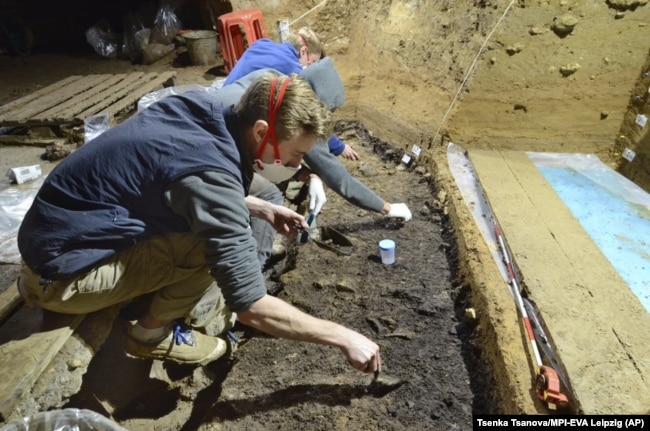私たち人間はいつヨーロッパ大陸に到着したのか?!
今日は祖先について。
新しい発見が次々なされ、学校で学んだ歴史が度々塗り替えられます。
さあ、今日は古代大陸へタイムトラベルしましょう。
VOAから最近の研究です。
古代人はヨーロッパにもっと早く入ったかもしれない
ブルガリアの人骨は、これまでの研究で示されていたよりも数千年前に人間が最初にヨーロッパに到着したことを示唆しています。これは、専門家が信じていたよりもはるかに長い間、人間に最も近い親戚であるネアンデルタール人と大陸を共有していたことを意味します。
科学者たちは4つの骨と歯を研究しました。詳細な放射性炭素と遺伝子検査の結果、これらは4つのホモ・サピエンスのものであり、そのうちの最も古いものは約46,000年前のものであることがわかりました。
研究に関する2つの別々のレポートは、科学出版物ネイチャーとネイチャーエコロジー&エボリューションに掲載されます。
ヘレン・フューラスは、報告書のうちの1つの主著者です。彼女はドイツの進化人類学のためのマックスプランク研究所に所属しています。
フューラス氏は、以前の最古のヨーロッパの人間の骨片はルーマニアで発見されたとAP通信に語っています。これらの骨片の年代を決定するための努力は問題をもたらしたのです、とも彼女は付け加えました。しかし、それらは数千年の差はあれど、4万年ほど前のものである可能性が高いのです。そして、その骨材にはネアンデルタール人の遺伝子が含まれており、ネアンデルタール人とホモ・サピエンスがおよそ200年前に交配していたことを示唆していました。
研究者たちは今、ヨーロッパの祖先は、短い温暖化期間中、約47,000年前にアフリカから来たと考えていると述べています。
これは、約7,000年ほどの間、ホモサピエンスとネアンデルタール人は同じ大陸に住んでいたことを意味し、少しは相互作用しながら、おそらくそれほど頻繁ではなかったでしょうが、ともう一つの研究の主著者であり、マックスプランク研究所の所長でもあるジャン・ジャック・ヒューブリンは言います。
ハブリン氏は、ネアンデルタール人は完全に約40,000年前に死亡したのだと言います。「我々は...(人間が)到着したときには、ネアンデルタール人がいたことを知っています」と彼は指摘しました。「ドナウ渓谷は、現代人がヨーロッパのこの地域に移動するための方法だったのかもしれません。
この初期の人間のグループは、おそらくアルプスと呼ばれる山々を越えて西に行くことはなかったでしょう、とハブリン氏は付け加えました。それはおそらく数百人しかいなかっただろうし、彼らは死んでしまったかもしれません。現代のヨーロッパ人は、アフリカからの人間の第二波の後から来た、と彼は言います。
残りは1930 年以降、科学者と公衆に公開されているブルガリアのBacho Kiro 洞窟で見つけられました。その洞窟は到達するには困難で、サイやライオンのものを含む動物の骨が入っているのです、とフューラス氏は言いました。
「人間が動物の体の一部を洞窟に持ち込んだのでなければ、それらはどうやって洞窟に入ったのでしょうか?」と彼女は尋ねます。
研究者たちは、洞窟の熊から大量の骨を回収しました。これらの初期のヨーロッパ人は、他の動物ではなく、洞窟のクマの骨から宝石を作っていて、クマとのつながりを示している、とハブリンは話しました。
この発見は、この時期まで宝石を作る技術を示していなかったネアンデルタール人が、人間から技術を学んだことを示唆しているのです、とハブリンは付け加えます。
この研究は非常に強力な議論を生み、「現代人類が西アジアから45,000年前にヨーロッパに分散したという仮説を大幅に強いものにします」とカテリーナ・ハルバティ氏は言っています。彼女はテュービンゲン大学の古人類学者です。彼女はこの研究には関与していません。
ハルバティ氏 は西ヨーロッパで見つけられたネアンデルタール人の宝石類が何らかの形で人間から学んだものだった可能性が高いという点でハブリン氏と意見が一致しています。他の研究者は、新たに発見された骨の年代を賞賛しています。しかし技術の教育が行われたかどうかについては不明であると述べています。
ホモサピエンスが唯一の人類となった謎
人類は、類人猿・猿人・原人・旧人・新人(ホモ・サピエンス)というステップで進化してきたそうです。
3~4万年前に、ネアンデルタール人は絶滅。
ホモサピエンスとの生存競争に敗れた事が原因と言うのが一般的な見方のようです。
①ネアンデルタール人の発声能力が現生人類より劣っていた為に、現生人類に比較してコミュニケーション能力が低かったこと
②ま単位集団の数が少なかったために、集団による大型哺乳類の狩りの成功率が現生人類よりも低かった為。
③ネアンデルタール人の出生率が低くかった為。(出生時の死亡事故)
ネアンデルタール人と人間の違いとは | SEKAI NO NEWS
諸説あり。
いかがでしたか?
未来にも過去にも興味は尽きません。
私たちはどこからきて、どこへ行くのでしょうか。AIと共に。。。
原文
Human bones from Bulgaria suggest human beings first arrived in Europe thousands of years earlier than previous studies have shown. This means humans shared the continent with Neanderthals, our closest relative, much longer than experts had believed.
Scientists studied four pieces of bone and a tooth. Detailed radiocarbon and genetic testing show they came from four Homo sapiens, the oldest of which is dated to about 46,000 years ago.
Two separate reports on the study appear in the scientific publications Nature and Nature Ecology & Evolution.
Helen Fewlass was a lead author of one of the reports. She is with the Max Planck Institute for Evolutionary Anthropology in Germany.
Fewlass told The Associated Press the previous oldest European human bone pieces were found in Romania. Efforts to date these bone pieces resulted in problems, she added. But they were likely from sometime around 40,000 years ago, give or take a few thousand years. And that bone material had Neanderthal genes in it, suggesting that Neanderthals and Homo sapiens had mated about 200 or so years earlier.
The researchers said they now think Europe’s ancestors came from Africa about 47,000 years ago during a short warming period.
This means that for about 7,000 years or so, humans and Neanderthals lived on the same continent, interacting a little, but probably not so often. So says Jean-Jacques Hublin, another study lead author and the director of the Max Planck Institute.
Hublin said Neanderthals completely died out about 40,000 years ago. “We know that when … (humans) arrived, there were Neanderthals,” he noted. “The Danube Valley might have been a way for modern humans — by the way, at different periods — to move into this part of Europe.”
This early group of humans probably never made it west over the mountains known as the Alps, Hublin added. It was likely only a few hundred people and they may have died off. Modern Europeans came from a second later wave of humans out of Africa, he said .
The remains were found in Bulgaria’s Bacho Kiro cave, which has been open to scientists and the public since 1930. The cave is hard to reach and contains animal bones, including those of a rhinoceros and lions, Fewlass said.
“How would they get into that cave … unless humans brought parts of the animal, the body, into the cave?” she asked.
Researchers have recovered a large amount of bones from cave bears. These early Europeans made jewelry out of cave bear bones, not other animals, showing a connection to the bears, Hublin said.
He added that the discovery suggests Neanderthals, who until this time period had not shown jewelry making skills, learned the skill from human beings.
The study makes a very strong argument and “greatly strengthens the hypothesis that modern humans dispersed into Europe before 45,000 years ago from Western Asia,” said Katerina Harvati. She is a paleoanthropologist at the University of Tuebingen. She was not involved in the study.
Harvati agreed with Hublin that it is likely that Neanderthal jewelry found in Western Europe was something that species somehow learned from humans. Other researchers praised the dating of the newly found bones. But they said they were unsure about whether the teaching of skills did happen.
Words in This Story
previous – adj. earlier in time or order
radiocarbon – n. the scientific way of finding the age of something that is very old by measuring the amount of radioactivity in certain forms of carbon in it
author – n. a person who has written something
interact(ing) – v. to talk or do things with other people
cave – n. a large hole that was formed by natural processes in the side of a cliff or hill or under the ground
jewelry – n. decorative objects, such as rings, necklaces, and earrings, that people wear on their body
hypothesis – n. an idea or theory that is not proven but that leads to further study or discussion
disperse(d) – v. to go or move in different directions : to spread apart
